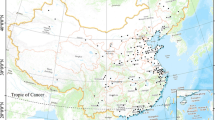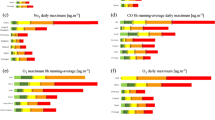Abstract
Air quality evaluation is important in order to inform the public about the risk level of air pollution to human health. To better assess air quality, China released its new national ambient air quality standards (NAAQS-2012) and the new method to classify air quality level (AQL) in 2012. In this study, we examined the performance of China’s NAAQS-2012 and AQL classification method through applying them, the World Health Organization (WHO) guidelines, and the US AQL classification method to evaluate air quality in Chengdu, the largest city in southwestern China. The results show that annual mean concentrations of PM10, PM2.5, SO2, NO2, and O3 at the seven urban sites were in the ranges of 138–161, 87–98, 18–32, 54–70, and 42–57 μg/m3, respectively, and the annual mean concentrations of CO were in the range of 1.09–1.28 mg/m3. Chengdu is located in one of the four largest regions affected by haze in China, and PM10 and PM2.5 were the top air pollutants, with annual concentrations over 2 times of their standards in NAAQS-2012 and over 7 times of the WHO guidelines. Annual mean concentrations of the pollutants were much lower at the background site (LYS) than at the urban sites, but the annual mean concentrations of PM10 and PM2.5 at LYS were 3.5 and 5.7 times of the WHO guidelines, respectively. These suggest that severe air pollution in Chengdu was largely associated with local emissions but also related to regional air pollution. The compliance rates of PM10, PM2.5, SO2, and O3 met China’s NAAQS-2012 standards four times more frequently than they met the WHO guidelines, as NAAQS-2012 uses the loosest interim target (IT) standards of WHO for these four pollutants. Air pollution in Chengdu was estimated and stated to be less severe using China’s classification than using the US classification, as China uses weaker concentration breakpoints and benign descriptions of AQL. Furthermore, China’s AQL classification method does not capture the cumulative effects of multiple pollutants, and the risk assessment is mainly based on the exposure-response relationship between air pollutant and human health quantified in the North America and West Europe; these can bring some uncertainties into evaluating the risk to human health in China. In summary, although China greatly improved its NAAQS and AQL classification method in 2012, further improvements are still needed.






Similar content being viewed by others
References
Alcorn, T. (2013). China’s skies: a complex recipe for pollution with no quick fix. The Lancet, 381, 1973–1974.
Andrews, S. Q. (2008). Inconsistencies in air quality metrics: ‘Blue Sky’ and PM10 concentrations in Beijing. Environmental Research Letters, 3. doi:10.1088/1748-9326/3/3/034009.
Andrews, S. Q. (2009). Seeing through the smog: understanding the limits of Chinese air pollution reporting. http://www.wilsoncenter.org/sites/default/files/andrews_feature_ces10.pdf.
Aunan, K., & Pan, X. C. (2004). Exposure-response functions for health effects of ambient air pollution applicable for China- a meta-analysis. Science of the Total Environment, 329, 3–16.
Baldauf, R. W., Lane, D. D., & Marote, G. A. (2001). Ambient air quality monitoring network design for assessing human health impacts from exposure to airborne contaminants. Environmental Monitoring and Assessment, 66, 63–76.
BMICIESIN. (2013). Global annual average PM 2.5 grids from MODIS and MISR Aerosol Optical Depth (AOD). Palisades: NASA Socioeconomic Data and Applications Center (SEDAC). doi:10.7927/H4H41PB4.
Cai, J., Zhao, A., Zhao, J. Z., Chen, R. J., Wang, W. B., Ha, S. D., Xu, X. H., & Kan, H. D. (2014). Acute effects of air pollution on asthma hospitalization in Shanghai, China. Environmental Pollution, 191, 139–144.
Chan, C. K., & Yao, X. H. (2008). Air pollution in mega cities in China. Atmospheric Environment, 42, 1–42.
Chen, R. J., Li, Y., Ma, Y. J., Pan, G. W., Zeng, G., Xu, X. H., Chen, B. H., & Kan, H. D. (2011). Coarse particles and mortality in three Chinese cities: the China Air Pollution and Health Effects Study (CAPES). Science of the Total Environment, 23, 4934–4938.
Chen, R. J., Samoli, E., Wong, C. M., Huang, W., Wang, Z. S., Chen, B. C., & Kan, H. D. (2012). Association between short-term exposure to nitrogen dioxide and mortality in 17 Chinese cities: the China Air Pollution and Health Effects Study (CAPES). Environment International, 45, 32–38.
Chen, R. J., Zhou, B., Kan, H. D., & Zhao, B. (2013a). Associations of particulate air pollution and daily mortality in 16 Chinese cities: an improved effect estimate after accounting for the indoor exposure to particles of outdoor origin. Environmental Pollution, 182, 278–282.
Chen, R. J., Wang, X., Meng, X., Hua, J., Zhou, Z. J., Chen, B. H., & Kan, H. D. (2013b). Communicationg air pollution-related health risks to the public: an application of the air quality health index in Shanghai, China. Environmental International, 51, 168–173.
CSB. (2013). Chengdu statistics yearbook 2012. http://www.cdstats.chengdu.gov.cn/uploadfiles/020703/2013%E3%80%81%E5%8C%BA%E5%B8%82%E5%8E%BF.pdf.
He, K. B., Huo, H., & Zhang, Q. (2002). Urban air pollution in China: current status, characteristics, and progress. Annual Review of Environment and Resources, 27, 397–431.
Kan, H. D., Chen, R. J., & Tong, S. L. (2012). Ambient air pollution, climate change, and population health in China. Environment International, 42, 10–19.
Kurokawal, J., Ohara, T., Morikawa, T., Hanayama, S., Janssens-Maenhout, G., Fukui, T., Kawashima, K., & Akimoto, H. (2013). Emissions of air pollutants and greenhouse gases over Asian regions during 2000-2008: regional emission inventory in ASia (REAS) version 2. Atmospheric Chemistry and Physics Discussion, 13, 10049–10123.
MEP. (2012a). Ambient air quality standard (GB3095-2012). http://kjs.mep.gov.cn/hjbhbz/bzwb/dqhjbh/dqhjzlbz/201203/W020120410330232398521.pdf.
MEP. (2012b). Notification of GB3095-2012 implementation. http://www.zhb.gov.cn/gkml/hbb/bwj/201203/t20120302_224147.htm.
MEP (2012c). Technical Regulation on Ambient Air Quality Index (on trial). http://kjs.mep.gov.cn/hjbhbz/bzwb/dqhjbh/jcgfffbz/201203/W020120410332725219541.pdf.
MEP. (2014). China statistical yearbook on environment. http://zls.mep.gov.cn/hjtj/nb/2012tjnb/.
NBSC. (2013).China statistical yearbook. http://data.stats.gov.cn/workspace/index?m=hgnd.
NDRC. (2013). Crucial situations of energy saving and emission reduction, and huge potentials of industrial development. http://www.sdpc.gov.cn/jjxsfx/t20130710_549549.htm.
Stieb, D. M., Burnett, R. T., Smith-Doiron, M., Brion, O., Shin, H. H., & Economou, V. (2008). A new multipollutant, no-threshold air quality health index based on short-term associations observed in daily time-series analyses. Journal of the Air & Waste Management Association, 58, 435–450.
Tao, J., Gao, J., Zhang, L., Zhang, R., Che, H., Zhang, Z., Lin, Z., Jing, J., Cao, J., & Hsu, S. C. (2014). PM2.5 pollution in megacity of southwest China: source apportionment and implication. Atmospheric Chemistry and Physics, 14, 8679–8699.
Tian, Y. Z., Wu, J. H., Shi, G. L., Wu, J. Y., Zhang, Y. F., Zhou, L. D., Zhang, P., & Feng, Y. C. (2013). Long-term variation of the levels, compositions and sources of size-resolved particulate matter in a megacity in China. Science of the Total Environment, 463–464, 462–468.
USEPA. (2012). Technical assistance document for the reporting of daily air quality- the air quality index (AQI). http://www.epa.gov/airnow/aqi-technical-assistance-document-sep2012.pdf.
USNRC. (1983). Risk assessment in the federal government: managing the process. http://www.nap.edu/catalog/366.html.
Wang, W. X., & Wang, T. (1995). On the origin and the trend of acid precipitation in China. Water, Air, & Soil Pollution, 85, 2295–2300.
Wang, X., Chen, R. J., Meng, X., Geng, F. H., Wang, C. C., & Kan, H. D. (2013). Association between fine particle, coarse particle, black carbon and hospistal visits in a Chinese city. Science of the Total Environment, 458-460, 1–6.
WHO. (2005). WHO air quality guidelines for particulate matter, ozone, nitrogen dioxide and sulfur dioxide. http://whqlibdoc.who.int/hq/2006/WHO_SDE_PHE_OEH_06.02_eng.pdf.
Yan, J. (2013). Characteristic research of ozone pollution of Chengdu urban at basin climate condition. Chengdu: Southwest Jiaotong University.
Yang, C. Y., Chen, A., Chen, R. J., Qi, Y. Q., Ye, J. J., Li, S. M., Liang, Z. J., Liang, Q., Guo, D. Q., Kan, H. D., & Chen, X. Y. (2014). Acute effect of ambient air pollution on heart failure in Guangzhou, China. International Journal of Cardiology, 2, 436–441.
Zhang, P., Zhou, D. L., & Wang, Z. Y. (2010). Analysis on the characteristics and sources of NO x in urban areas of Chengdu. Paper Presented at the Annual Conference of Technology of Chengdu, 96–102.
Zhang, Q., He, K. B., & Huo, H. (2012a). Policy: cleaning China’s air. Nature, 484, 161–162.
Zhang, X. Y., Wang, Y. Q., Niu, T., Zhang, X. C., Gong, S. L., Zhang, Y. M., & Sun, J. Y. (2012b). Atmospheric aerosol composition in China: spatial/temporal variability, chemical signature, regional haze distribution and comparisons with global aerosols. Atmospheric Chemistry and Physics, 12, 779–799.
Zhou, B., Zhao, B., Guo, X. F., Chen, R. J., & Kan, H. D. (2013). Investigating the geographical heterogeneity in PM10- mortality associations in the China Air Pollution and Health Effects Study (CAPES): a potential role of indoor exposure to PM10 of outdoor origin. Atmospheric Environment, 75, 217–223.
Zhou, M. G., Liu, Y. N., Wang, L. J., Kuang, X. Y., Xu, X. H., & Kan, H. D. (2014). Particulate air pollution and mortality in a cohort of Chinese men. Environmental Pollution, 186, 1–6.
Acknowledgments
This study is sponsored by the Program of Introducing Talents of Discipline to Universities (B08037), the International Program of the Ministry of Science and Technology of China (2010DFA91280), and the National Science Foundation of China (21407110). The authors would also like to thank the two anonymous reviewers for their valuable comments and suggestions.
Author information
Authors and Affiliations
Corresponding author
Electronic supplementary material
Below is the link to the electronic supplementary material.
Table S1
(DOCX 18 kb)
Rights and permissions
About this article
Cite this article
Qiao, X., Jaffe, D., Tang, Y. et al. Evaluation of air quality in Chengdu, Sichuan Basin, China: are China’s air quality standards sufficient yet?. Environ Monit Assess 187, 250 (2015). https://doi.org/10.1007/s10661-015-4500-z
Received:
Accepted:
Published:
DOI: https://doi.org/10.1007/s10661-015-4500-z




